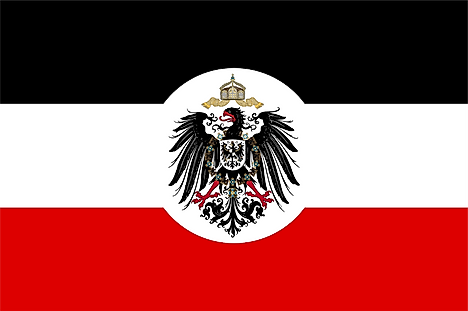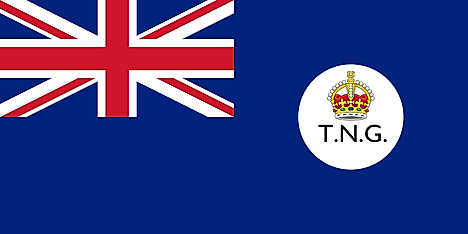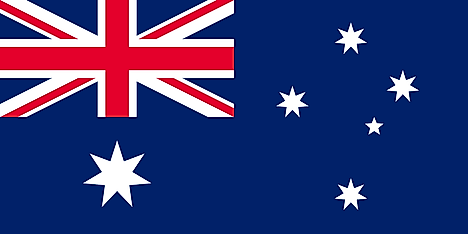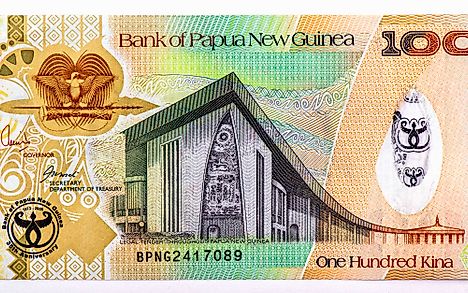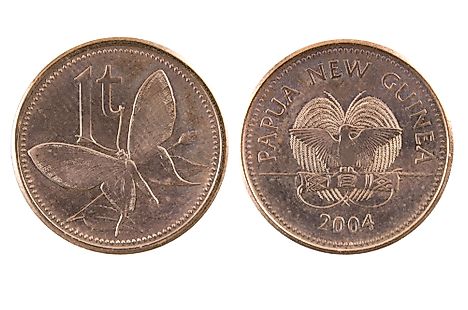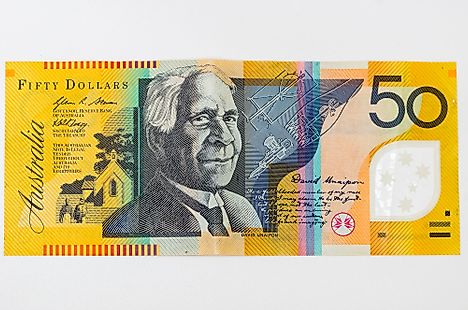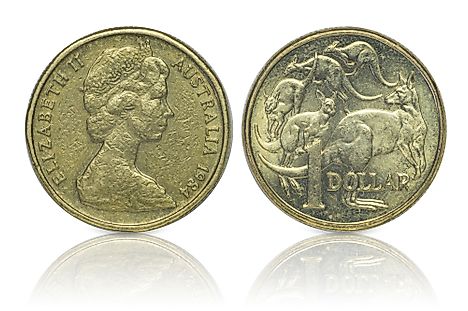Flags, Symbols & Currency of Papua New Guinea
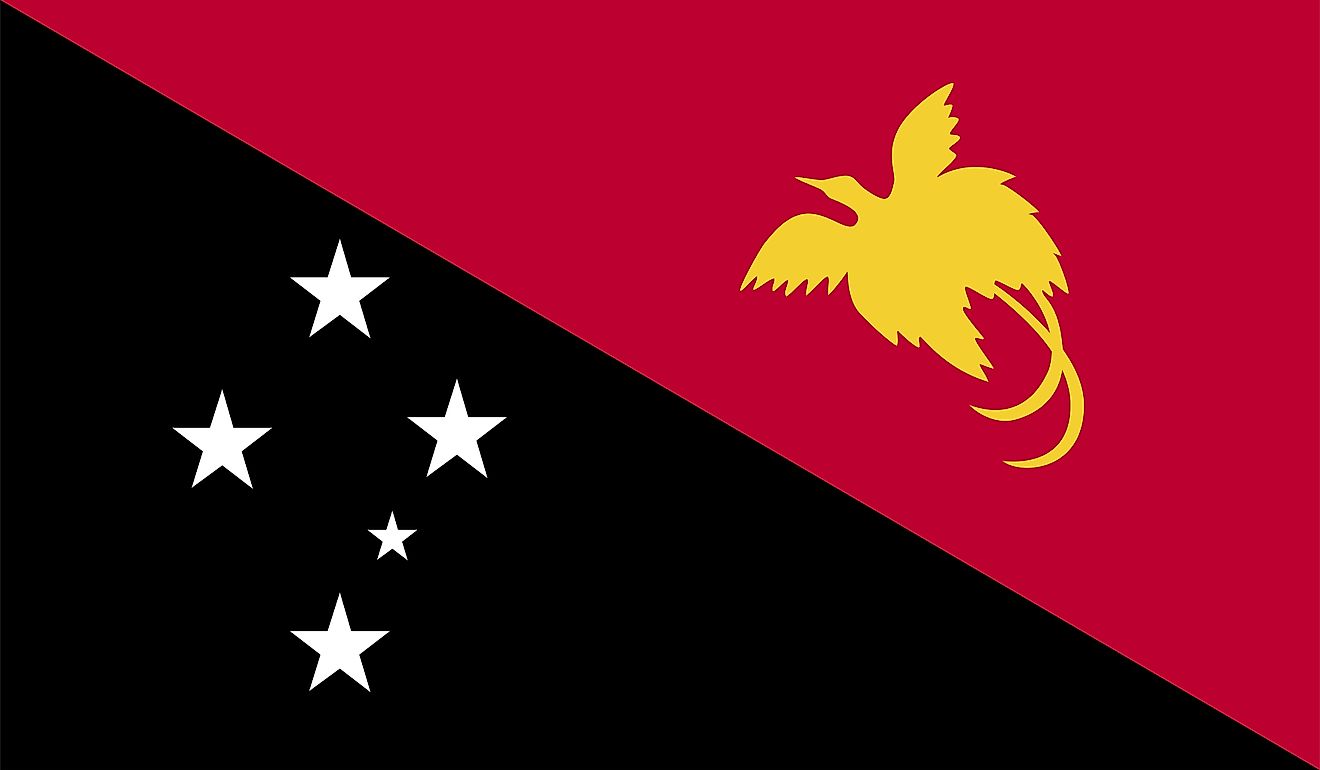
The National Flag of Papua New Guinea was officially adopted on July 1, 1971.
The National Flag of Papua New Guinea is a bicolor that is divided diagonally into two triangles, from the upper hoist-side corner to the fly-side's lower corner. The upper triangle is red and features a soaring yellow Raggiana bird-of-paradise. The lower triangle is black and features four white, five-pointed larger stars and a smaller white, five-pointed star, arranged in a pattern resembling the Southern Cross constellation. Red, black, and yellow are traditional colors of Papua New Guinea and have been used by many of the country’s tribes for centuries. The bird of paradise - endemic to the island of New Guinea - is an emblem of regional tribal culture and represents the emergence of Papua New Guinea as a nation. The Southern Cross is a reminder of the country’s position in the Southern Hemisphere and its connection with Australia and several other countries in the South Pacific. The flag has a width-to-length ratio of 3:4.
History of the flag of Papua New Guinea
Germany occupied parts of Papua New Guinea in 1884 and ruled over the region for a few decades. During WWI, Australia occupied the German New Guinea and remained in power even after the war. The southern half of the country had already been colonized by Britain in 1884. In 1905, the control of this region was transferred by the UK to the Commonwealth of Australia. However, it remained in possession of the UK by law. Thus, British New Guinea (now renamed Territory of Papua) and German New Guinea (now part of Australia) had separate administrations but both were controlled by Australia. The two territories were united after WWII to form the Territory of Papua and New Guinea. Before the independence of the country, a new flag was proposed by the Australian government. It had three colors: blue, green, and yellow. The flag also featured the Southern Cross and the Bird-of-paradise. However, the flag was not accepted by the people of the country. Instead, a nationwide competition was held in 1971 to design the flag, and the 15-year-old Susan Karike Huhume was selected as the winner. The national flag was then adopted on July 1, 1971, and on September 16, 1975, an independent nation of Papua New Guinea emerged.
Symbols of Papua New Guinea
The National Coat of Arms of Papua New Guinea
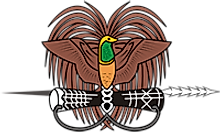
The National Coat of Arms/Emblem of Papua New Guinea was adopted on July 1, 1971. It is composed of a Raggiana Bird-of-paradise standing above a traditional spear and Kundu drum. The National Coat of Arms of Papua New Guinea has been designed by Hal Holman.
National Motto
“Unity in Diversity”
National Anthem
- Anthem Title: "O Arise, All You Sons"
- Music Composer: Thomas Shacklady
- Lyricist: Thomas Shacklady
- Date pf Adoption: 1975
"O Arise, All You Sons" is the national anthem of Papua New Guinea. The music and the lyrics of the anthem have been created by Thomas Shacklady. The anthem was officially adopted in 1975.
"O, Arise, All You Sons"
O arise all you sons of this land,
Let us sing of our joy to be free,
Praising God and rejoicing to be
Papua New Guinea.
Shout our name from the mountains to the seas
Papua New Guinea;
Let us raise our voices and proclaim
Papua New Guinea.
Now give thanks to the good Lord above
For His kindness, His wisdom and love
For this land of our fathers so free,
Papua New Guinea.
Shout again for the whole world to hear
Papua New Guinea;
We are independent and we're free
Papua New Guinea.
The Currency of Papua New Guinea is the kina
The current official currency of Papua New Guinea is kina. Kina is sub portioned into 100 parts called toea. The word kina is extracted from the Kuanua language of Tolai meaning a caluable pearl shell commonly used for trading in both the coastal and highland regions of the country. Kina was developed and adopted on 19th April 1975 to substitute the Australian dollar at an equal amount.
Coins
The first series of coins was pioneered in 1975 in denominations of 1, 2,5,10, and 20 toea and 1 kina. The 1 and 2 toea were produced from bronze while the other coins were minted from cupronickel. The 1 kina is circular and it is holed in the middle. From 2006, the coins have been minimized in size, with the largest coin being demonetized in December of 2008. There was a production of a double metallic 2 kina coin minted to substitute the 2 kina note. In 2006, there was the elimination of 1 and 2 toea coins after the end of the legal tender. 50 toea coins were later minted in 1980 but were only circulated in commemorative form without a standard label. All the denominations of coins contain the national emblem on the backside and were circular except the 50 toea which is heptagonal. The current 50 kina note contains the portrait of Prime Minister Michael Somare. 1 toea coin displays a birdwing butterfly and the 2 toea coin displays a lionfish on their obverse.
Banknotes
The first series of banknotes was introduced on the 19th of April, 1975 in denominations of 2, 5, and 10 kina. These notes substituted the Australian dollar at the same face value. They were adopted and circulated alongside the Australian dollar until 1976 when the legal tender for the dollar was terminated. A 20 kina note was minted in 1977, and a 100 kina note was introduced in 2005. All notes were designed with the same color, similar to their Australian dollar equivalents. Since 1991, Papua New Guinea's notes have been developed from a polymer but in 2009, the bank produced kina, and toea day commemorating notes on paper substrates were circulated. All banknotes of Papua New Guinea (1975 issue) contain an image of a bird of paradise, a spear, and a carved hourglass on the obverse side of the notes. The banknote series of the 1981 issue contains an image of a bird of paradise, spear, except the 50 kina note which contains an image of the parliament building in Port Moresby. All the current banknote issue contains an image of the parliament building on the obverse side.
Historical currencies of Papua New Guinea
During the colonial period, several different currencies were in circulation in Papua New Guinea. These currencies were: German mark, Pfennings, Japanese Yen, Australian Pounds, Shillings and Pence, the New Guinean pound, the Guinean mark, and the most recent Australian dollar. Kina was adopted in 1975 and replaced the Australian dollar as the currency of Papua New Guinea.
